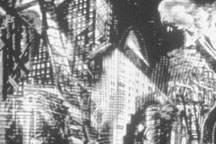New Cyber Sights
The future of electronic imagery dazzles the eye and piques the mind at the San Jose Museum of Art
By Christina Waters
WHEN WILLIAM Gibson wrote of a future sky "the color of television, tuned to a dead channel," we struggled to imagine that particular hue and its location in the unfamiliar cyberworld prophesied in Neuromancer. That elusive tint is clearly visible (of course "where" must remain an invisible counterpoint to embodied reality) haunting the margins of several pieces in the new show Metamorphoses: Photography in the Electronic Age, recently opened at the San Jose Museum of Art.
A hefty survey, 75 works strong, of the forefront of technographic imagery, the show detonates our clichéd databank of Photoshopped trompe l'oeil and Sega eye-poppery. What we're presented with isn't so much an archive of electronic razzle-dazzle, as it is a manipulation of wonder, an uploading of questions that use rather than serve, electronic devices. Vision, not technology, is clearly in charge.
The effect of all these strikingly different uses of digitized palettes and printouts is at once eerie and yet sensuously familiar. Like a dream you struggle to remember and only catch the provocative tail-end of--just the most fleeting scent and feel--these pieces tend toward hyper-reality, a magical realism, in which we're morphed into the very cellular structure of natural elements and political agendas.
Most astonishing is the diversity of styles, the range of virtuosity reverberating through the show's works. As part of a sampling of innovations made possible by his Iris ink-jet printing system, musician/photographer Graham Nash offers a 1991 piece called Chrome Magnum, in which a face, at once dissolving and reassembling, rises out of a sea of molten ink so intensely black that it suggests every color of the rainbow.
In works that shimmer with magic realism, Pedro Meyer creates a series of wildly colored large photographs, slyly altering religious festivals and street scenes in Mexico's Oaxaca so that polychrome saints "float" among the faithful, and angels uneasily inhabit a quiet corner of a marketplace.
Such manipulation works both to portray a visually astonishing imaginary space, as well as visualize the living faith of Indian villagers for whom ancient animism never quite succumbs to European Catholicism.
Some computer-manipulated pieces, like Barbara Kasten's El Mèdol, Roman Quarry, lavishly deconstruct and reconstruct a photographed site, first dramatized by artificial lighting, then radically altered through color scanning. In creating a completely fictitious image of the quarry, the artist heightens the hardness of the stone and the empty grandeur of this once-imperial, now neglected quarry.
OTHERS, LIKE Martina Lopez, work by a layering of composite imagery. Selecting, enlarging and recombining old family photographs into a metaphoric landscape, Lopez achieves photomontages on a grand scale.
The expansive Cibachrome panels come close to recapturing an heirloom past while questioning the very fabric of time lived backward toward ancestors, and forward toward generations yet unborn. Lopez' beautiful, sad-eyed images force us to see previously "invisible" structures, populated with objects whose impossible physics exists only in its creator's imagination.
The level of technique shimmering throughout all these pieces hits its stride in the brilliant cyber-prop of Osamu James Nakagawa, whose unsettling alliances of urban anonymity and rural nostalgia have been widely published in recent art journals. Even if they hadn't been, Nakagawa's images would feel familiar. Uncomfortably so.
Digitally transplanted from some long-ago rally, hooded Ku Klux Klan zealots stride across a drive-in movie screen in the middle of a dusty, weed-infested nowhere. Martin Luther King Jr. and cowboys riding the range on a downtown Tokyo billboard are among the message-heavy symbols Nakagawa deftly cuts from one context and pastes into another.
With few exceptions, each selection in this powerful show is startling in its electronic expertise and in the clarity of its artistic suggestion--we're a long, long way from Photoshop 101 here, even though the primary corporate sponsor for the show's San Jose visit is, appropriately, Adobe Systems. At its best, Metamorphoses is loaded with cyberspace ships fully fueled to take us somewhere we've never gone before.
[ Metro | Metroactive Central | Archives ]
This page was designed and created by the Boulevards team.

Cityscape of the Future: A detail of artist Annette Weintraub's ominous photomontage "Lifeline"
Metamorphoses: Photography in the Electronic Age shows through Nov. 10 at the San Jose Museum of Art, 110 S. Market St., San Jose (408/271-6840). A companion show, Pixel Perfect: Digital Photography in the Bay Area runs concurrently.
From the September 5-11, 1996 issue of Metro
Copyright © 1996 Metro Publishing, Inc.
![[Metroactive Arts]](/arts/gifs/art.gif)